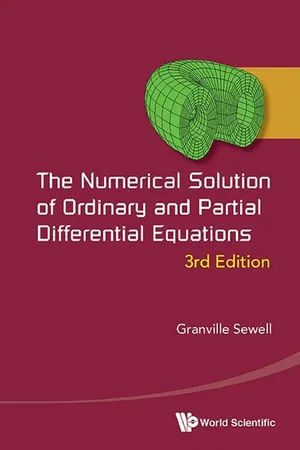
The Numerical Solution of Ordinary and Partial Differential Equations
Granville Sewell
- 318 pages
- English
- ePUB (mobile friendly)
- Available on iOS & Android
The Numerical Solution of Ordinary and Partial Differential Equations
Granville Sewell
About This Book
This book presents methods for the computational solution of differential equations, both ordinary and partial, time-dependent and steady-state. Finite difference methods are introduced and analyzed in the first four chapters, and finite element methods are studied in chapter five. A very general-purpose and widely-used finite element program, PDE2D, which implements many of the methods studied in the earlier chapters, is presented and documented in Appendix A.
The book contains the relevant theory and error analysis for most of the methods studied, but also emphasizes the practical aspects involved in implementing the methods. Students using this book will actually see and write programs (FORTRAN or MATLAB) for solving ordinary and partial differential equations, using both finite differences and finite elements. In addition, they will be able to solve very difficult partial differential equations using the software PDE2D, presented in Appendix A. PDE2D solves very general steady-state, time-dependent and eigenvalue PDE systems, in 1D intervals, general 2D regions, and a wide range of simple 3D regions.
Contents:
- Direct Solution of Linear Systems
- Initial Value Ordinary Differential Equations
- The Initial Value Diffusion Problem
- The Initial Value Transport and Wave Problems
- Boundary Value Problems
- The Finite Element Methods
- Appendix A — Solving PDEs with PDE2D
- Appendix B — The Fourier Stability Method
- Appendix C — MATLAB Programs
- Appendix D — Answers to Selected Exercises
Readership: Undergraduate, graduate students and researchers.
Key Features:
- The discussion of stability, absolute stability and stiffness in Chapter 1 is clearer than in other texts
- Students will actually learn to write programs solving a range of simple PDEs using the finite element method in chapter 5
- In Appendix A, students will be able to solve quite difficult PDEs, using the author's software package, PDE2D. (a free version is available which solves small to moderate sized problems)
Frequently asked questions
Information
Initial Value Ordinary Differential Equations




Table of contents
- Cover
- Halftitle
- Title
- Copyright
- Dedication
- Contents
- Preface
- 0 Direct Solution of Linear Systems
- 1 Initial Value Ordinary Differential Equations
- 2 The Initial Value Diffusion Problem
- 3 The Initial Value Transport and Wave Problems
- 4 Boundary Value Problems
- 5 The Finite Element Method
- Appendix A—Solving PDEs with PDE2D
- Appendix B—The Fourier Stability Method
- Appendix C—MATLAB Programs
- Appendix D—Answers to Selected Exercises
- References
- Index